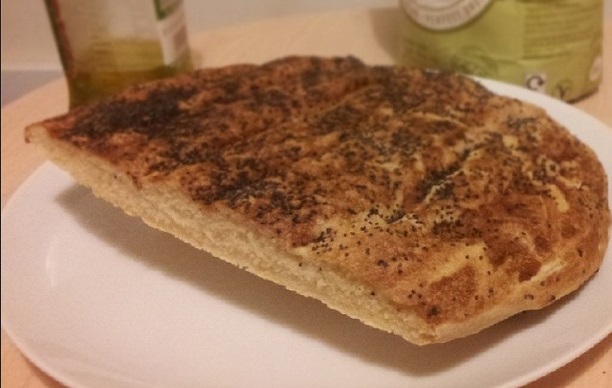White Bread is both delicious, and the easiest type of bread to master. Once you have the basic recipe for this dough sorted, you can turn it into all types of loaves – cob loaves, tin loaves, cottage loaves, all have their starting point in this basic dough.
[one_half]1) Put the flour in a mixing bowl. Add the salt to one side of the bowl, and the yeast to the other, being careful not to let them touch (this would retard the yeast and prevent it from rising). Add the butter or margarine and 3/4 of the water, and mix with your hands, adding the rest of the water as necessary, until you have picked up all the remaining flour from the bowl. You may need to use a little less than 320ml of water, or a little more, depending on the bread flour you use.2) Lightly oil a work surface. Scrape the dough onto the oiled surface, and knead for 5-10 minutes, until the mixture becomes smooth, silky and springy, and starts to form a smooth skin. [/one_half] [one_half_last][alert type=”blue”]You will need:
500g Strong white bread flour, plus extra for dusting
10g instant-action yeast
10g salt
30g butter or margarine
320ml water
Olive oil for kneading[/alert][/one_half_last]
Then leave the mixture in a lightly oiled mixing bowl, covered with a tea towel, until the dough has at least doubled in size – at least 1 hour, although you can leave it for longer.
3) Scrape the dough onto a lightly floured surface and “knock back” the dough, turning the mixture in on itself until all of the air has been expelled.
At this point, you can turn the dough into a variety of loaves.
[tabgroup][tab title=”Tin Loaf”]4) Lightly oil a loaf tin. Flatten the dough slightly into a rectangle shape, and fold the sides into the middle. Roll the dough up, with the join hidden underneath, and place into your tin.
5)Put the tin inside of a clean plastic bag to prove for about 1 hour. During this time, preheat your oven to 230°C, with a roasting tin in the bottom of the oven to heat up.
6) After the loaf has proved for about 1 hour, dust the top of your loaf with flour, and slash down the middle with a knife. Fill the roasting tin in the oven with hot water – this will produce steam and create a lighter crust.
7) Bake the tin in the oven for roughly 30 minutes – you can check that the loaf is baked by tipping it out of the tin and tapping the base. If it makes a hollow noise, it is baked. Cool on a wire rack. [/tab] [tab title=”Cob Loaf”]
4) Shape the dough into a ball by stretching and tucking the dough underneath itself. This will eventually form a smooth top, with a rough underside. Place on a piece of baking parchment or silicone sheet on a baking tray, and place inside of a clean plastic bag to prove for about 1 hour. During this time, preheat your oven to 230°C.
5) After the bread has proved for about 1 hour, dust the top of your loaf with flour. Slash the top of the loaf with a knife, then place in the oven and bake for roughly 30 minutes – you can tell if the bread is baked by tapping the base of the loaf. If it makes a hollow noise, it is baked. Cool on a wire rack.[/tab] [tab title=”Cottage loaf”]
4) Divide the dough into 2, with one piece twice the size of the other. Shape both pieces into balls by stretching and tucking the dough underneath itself, forming a smooth top with a rough underside.
5) Place the smaller ball on top of the larger one. Dust your middle and index fingers with flour, and push them through the two balls of dough, creating a hole in the middle of the loaf.
6) Place the loaf on a baking tray lined with baking parchment or a silicone sheet. Place into a clean plastic bag, and leave to prove for about 1 hour. During this time, preheat your oven to 230°C.
7) After the loaf has proved for about 1 hour, bake for about 30 minutes – you can tell if the bread is baked by tapping the base of the loaf. If it makes a hollow noise, it is baked. Cool on a wire rack.[/tab][/tabgroup]








